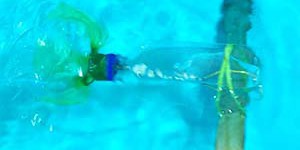Third Grade, Aerodynamics & Hydrodynamics Science Projects (19 results)
You've seen for yourself, or in videos, planes flying, rockets hurdling towards space, boats racing through the water and submarines exploring the depths of the ocean. Have you ever stopped and thought about the aerodynamics and hydrodynamics involved in their operation? There is a lot of interesting science that goes into how they work!
|
Select a resource
Coding Projects
Sort by
|
Just one sheet of paper can lead to a whole lot of fun. How? Paper planes! All you have to know is how to fold and you can have a simple plane in a matter of minutes! But what design should you use to build the best plane? In this aerodynamics science project, you will change the basic design of a paper plane and see how this affects its flight. Specifically, you will increase how much drag the plane experiences and see if this changes how far the paper plane flies. There is a lot of cool…
Read more
How does a parachute work? Do bigger parachutes work better than smaller parachutes? Find out in this science project if the size of the parachute matters.
Read more
New
How do you feel right now? Do you remember how you felt a few hours ago? How about yesterday or last Wednesday? What if you could track your emotions throughout the day and use this information to help improve your mood and well-being? In this science project, you will program a simple, pocket-sized device that you can carry around with you to log your feelings whenever you want or on a specific schedule.
Read more
How does weight affect a drone's speed? Is there a limit to how much weight a drone can lift? Find out with your own mini popsicle stick drone in this fun science project!
Read more
Kites have been a source of entertainment for centuries for kids from cultures around the world. In this science project you will have a chance to build your very own kite, a simple sled kite. Then you will use it to investigate how kites fly. Will you find out the best way to fly your kite?
Read more
Do you dream about making deep, undersea voyages? Let this project take you 20,000 leagues under the sea! Investigate how submarines dive and surface by changing their buoyancy in this fun project.
Read more
New
Have you ever walked next to your favorite ocean, lake, or creek and seen plastic waste everywhere? Have you ever thought about how much plastic breaks down into microplastics and pollutes waterways? Scientists are coming up with new ways to remove these microplastics from our waterways, and now you can test them out for yourself at home.
Read more
Have you ever wondered how a ship made of steel can float? Or better yet, how can a steel ship carry a heavy load without sinking? In this science project you will make little "boats" out of aluminum foil to investigate how their size and shape affects much weight they can carry and how this relates to the density of water.
Read more
Have you ever seen a helicopter flying through the sky? It can be difficult to do a science project with a real helicopter, so in this project we will show you how to make a miniature paper helicopter called a whirlybird. Will your whirlybird be able to stay in the air as you add paper clips as weights? Try this project to find out!
Read more
Have you ever looked up into the sky and seen not a bird, not a plane, but a hot-air balloon? They are definitely amazing and fun to watch! Do you think they are all the same size? Does size affect how long the hot-air balloon can fly? In this science fair project, you will launch hot-air balloons, powered by a toaster, and see how the size of the balloon affects its flight.
Read more
Have you ever seen butterflies fluttering around outside, gliding through the air and landing on flowers? While they are delicate and fragile, butterflies are actually excellent flyers. They are so good, in fact, that scientists at Harvard University studied butterfly wing shapes as an inspiration for building a miniature flying robot. In this science project, you will do your own version of the Harvard scientists' experiment to measure the flight performance of butterfly wings.
Read more
What keeps a submarine from spinning out of control? In this science project, you can investigate how
submarines use stabilizing fins to move forward. You might even figure out the secrets to maneuvering a submarine!
Read more
|

















